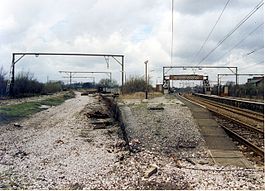Godley East railway station
| Godley East | |
|---|---|

Station in 1989.
|
|
| Location | |
| Place | Godley |
| Area | Tameside |
| Grid reference | SJ968946 |
| Operations | |
| Original company |
Sheffield, Ashton-under-Lyne and Manchester Railway (1st station) Manchester, Sheffield and Lincolnshire Railway (2nd station) |
| Pre-grouping | Great Central Railway |
| Post-grouping | London and North Eastern Railway |
| Platforms | 4 |
| History | |
| 17 November 1841 | Godley Toll Bar opened |
| 11 December 1842 | Closed |
| 1 February 1866 | Godley Junction opened |
| 6 May 1974 | Renamed Godley |
| 7 July 1986 | Renamed Godley East |
| 27 May 1995 | Closed |
| Disused railway stations in the United Kingdom | |
| Closed railway stations in Britain A B C D–F G H–J K–L M–O P–R S T–V W–Z |
|
|
|
|
Godley East was a railway station in the Godley area of Hyde, Tameside, Greater Manchester, on the Woodhead Line.
On 17 November 1841, Godley was the temporary terminus of the Sheffield, Ashton-under-Lyne and Manchester Railway's (SAuLMR) line from Manchester Store Street. The station was located close to the Hyde and Mottram Road and was sometimes referred to as "Godley Toll Bar". It closed on 11 December 1842 when the line was extended to Broadbottom. A permanent station was opened after the Cheshire Lines Committee (CLC) opened the as far as Broadheath on 1 February 1866 and the SAuLMR, by now renamed as the Manchester, Sheffield and Lincolnshire Railway (MS&LR), opened a line from Woodley to Godley via Apethorne Junction.
The station, which was named as "Godley Junction", had four platform faces: two on the Manchester line and two on the CLC route. The CLC platforms were only ever lightly used. The station and sidings were controlled by a single mechanical signal box which was located at the east end of the 'up' (Hadfield) platform.
The connection to Woodley gave the MS&LR access to the Port of Liverpool without the need go via Manchester. This resulted in Godley becoming the point where freight traffic from as far away as Merseyside met with traffic going to and fro over the Pennines.Exchange sidings were laid on both the MS&LR and the CLC sides of the station; those on the CLC side were known as Brookfold Sidings. Brookfold Sidings had their own turntable and signal box. A CLC traffic office was based at Godley and, during the Second World War, the London and North Eastern Railway had an operational headquarters at the rear of the Up main line platform which controlled operations as far east as Wath and Doncaster.
...
Wikipedia
